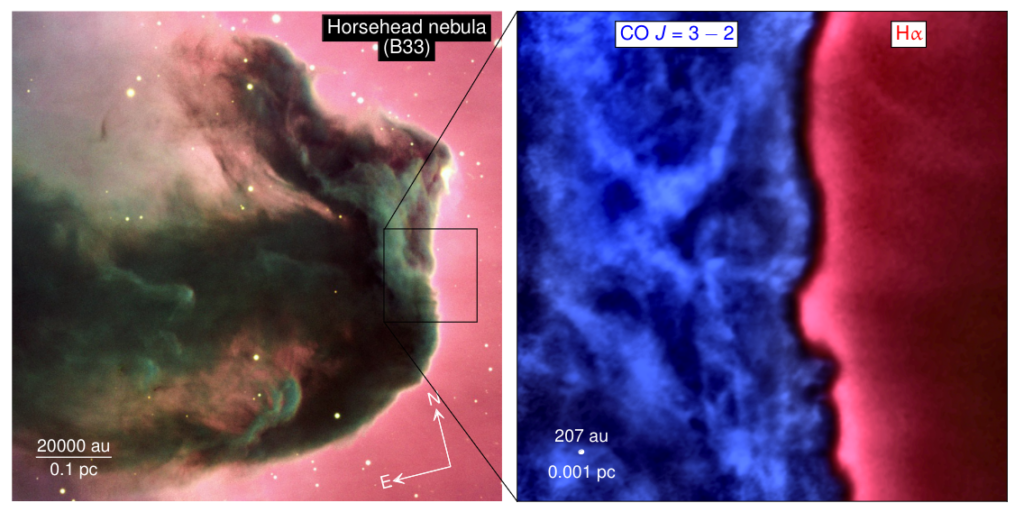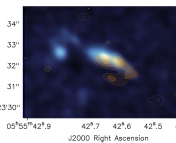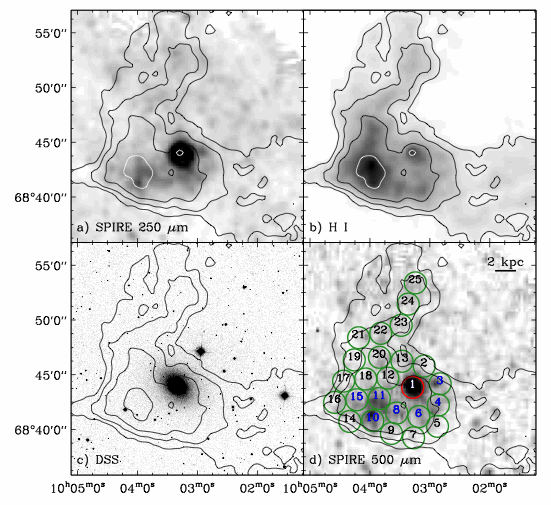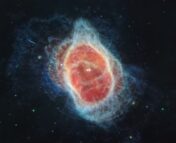Title: The extremely sharp transition between molecular and ionized gas in the Horsehead nebula
Authors: C. Hernández-Vera, V. V. Guzmán, J. R. Goicoechea, V. Maillard, J. Pety, F. Le Petit, M. Gerin, E. Bron, E. Roueff, A. Abergel, T. Schirmer, J. Carpenter, P. Gratier, K. Gordon, K. Misselt
First Author’s Institution: Instituto de Astrofísica, Pontificia Universidad Católica de Chile, Santiago, Chile
Status: [Accepted to] A&A [open access]
Gas in the Galactic Ecosystem
One thing that tends to surprise people when studying galaxies is the fact that a lot of the (ordinary) matter in galaxies is not in stars at all, but instead in diffuse, free-floating hydrogen gas (known as the interstellar medium, or ISM). A natural consequence of this is that a lot of the study of galaxies is the study of this hydrogen gas, and all of its various ‘phases’. The gas exists in three main phases: molecular gas, which is gas that’s so cold and dense that the hydrogen groups up into H2 molecules, atomic gas, which, as the name suggests, is in the form of loose, neutral hydrogen atoms, and ionized gas, where the gas is so hot that the electrons have been stripped off the hydrogen atoms, turning them into ions. A galaxy’s ISM does an amazing job of organizing its hydrogen into these discrete phases, with very small transition regions between the phases.
While this loose hydrogen dominates the mass of the galaxy, stars are still a vital part of the galactic ecosystem that controls how the hydrogen behaves. The ISM is constantly undergoing a sort of life cycle – hot gas loses energy over time, cooling and condensing it from ionized gas to atomic gas to molecular clouds, which then themselves cool and condense until they’re dense enough to ignite nuclear fusion and become a star. Stars then spew the byproducts of this nuclear fusion (energy, in the form of either stellar winds or UV photons energetic enough to ionize hydrogen) back into the molecular gas, ripping it apart and ionizing it, starting the cycle anew. Astronomers refer to this link between stars and their surroundings as stellar feedback.
Actions and Reactions
Feedback is a critical part of how stars (and therefore entire galaxies) come to be, but astronomers still don’t understand many of the details surrounding feedback. The scales on which feedback acts are still not clear. How quickly does the transition from molecular to ionized gas happen? What is the structure of a clump of molecular gas? The type of energy from the star that’s causing the feedback is also still an open question. Is it mostly the dynamic pushing force from stellar winds causing feedback? Or the energetic UV photons being radiated from the star?
The Horsehead
In today’s paper, the authors aim to answer these questions by looking at a snapshot of stellar feedback happening in real-time: the Horsehead Nebula (also a famous target for amateur astronomers!). The Horsehead Nebula is a shred of molecular gas, once part of a much larger molecular cloud that was ripped apart by a star it helped birth (the nearby σ Orionis). The remnants of this molecular cloud are now being bombarded by energy from this new star, making it a nearby place to study how these feedback processes happen in detail.

The Horsehead Nebula is very nearby (around 400 parsecs, or 1600 light-years), and thus has historically been an important target for astronomers studying molecular clouds, meaning it’s been observed extensively across many wavelengths of light. Today’s authors bring to the table new observations of the nebula using ALMA, the Atacama Large Millimeter Array (a network of telescopes operating at millimeter and submillimeter wavelengths in the Atacama desert in Chile). ALMA uses interferometry to achieve angular resolutions higher than almost any other telescope is capable of, and the submillimeter wavelengths at which ALMA operates are perfect for studying the molecular phases of the ISM. This meant that, using ALMA, the authors could measure details of the transition region where the ISM switches from ionized to molecular gas more closely than ever before.

A Well-Defined Horse
The first, and most important, thing that the authors found was that the transition from ionized gas all the way to molecular gas happens in a very small region of space. The authors measured a transition region of atomic gas (shown in 1 dimension in Figure 2) that was at most 650 AU (0.003 parsec, or 0.01 light-year). This value is actually an upper limit, as it’s still not fully resolved even by the high-resolution ALMA observations. It’s possible this transition region is even smaller. The authors also confirmed that the molecular gas (the white contours and the image in the right panel of Figure 2) has a very clumpy, filamentary structure once inside the Horsehead Nebula. Many of the filaments are directly parallel to the transition region. The ionized gas (indicated by green contours in the right panel of Figure 2) is much smoother and more regularly-distributed. This makes sense – the ionized gas is much hotter and much less dense, so it moves around to fill available space much more easily.
Winds or Radiation?
The other thing that the authors investigated was the type of feedback acting on the Horsehead Nebula – is it just the ionizing radiation from the star, or are there also dynamical effects (i.e., stellar winds pushing on the gas)? The authors used measurements of line intensity as a function of distance from the illuminating star (as shown in the left panel of Figure 2) to estimate the temperature and density (and therefore the pressure) of the gas at each point, and found that these measurements match with models where the input energy is all radiation. However, these models depend on the size of the transition region, which, as mentioned above, is only an upper limit. If the transition region is much smaller than the upper limit given, it’s possible that winds could also be affecting the gas. The filamentary structure of the molecular gas (especially the fact that the filaments are parallel to the edge of the cloud) also suggests dynamical effects.
The Future of the Horsehead
Ultimately, the authors weren’t able to narrow down the source of the stellar feedback with the current observations, which means that the next steps are easy: they need more observations! The high-resolution ALMA observations are great, but figuring out the exact size of the transition region requires high-resolution observations of other molecular gas tracers as well. There are some infrared lines emitted by molecular hydrogen that could be measured with instruments on JWST, which is also (comparably) high-resolution. This will help constrain the pressure of the molecular gas, which will in turn help to determine if dynamical effects are present. The complex ecosystem of actions and reactions happening in the gas in galaxies is very important to understand if we want to understand how galaxies came to be, and the Horsehead Nebula is a great step towards understanding that!
Astrobite edited by Megan Masterson
Featured image credit: ESO




